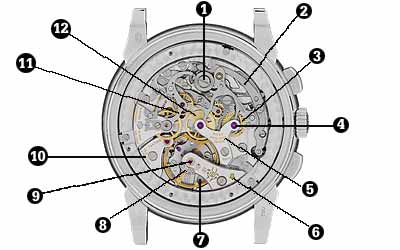

Can a watch really be worth $89,600? That’s the list price on Patek Philippe’s new Perpetual Calendar Chronograph 5970. Considered the world’s premium watchmaker alongside Rolex, Patek commands a brand markup of at least 25 percent above the cost of Swiss craftsmanship and the very complex parts that make simple digital functions like a stopwatch and a calendar work entirely without electronics. Here, a look inside the 5970’s chronograph function (there’s another layer for the calendar, too).
1. Column Wheel
The steel command center of the chronograph function—a.k.a. the stopwatch—it connects all the other parts that make the chronograph work.
2. Start and Stop Lever
Triggers the column wheel, which in turn starts the second hand.
3. Minute Register Wheel
Counts the passing minutes. Like the other wheels, its teeth and pinions are cut and polished by hand.
4. Pivot
The point in the watch where there’s the most friction—which is reduced by a synthetic ruby. This is also where the watch is oiled.
5. Geneva Stripes
A decorative pattern done with a wooden wheel that appears on all bridges. Aside from its decorative function, it makes them smooth and corrosion-resistant.
6. Geneva Seal
This indicates the watch has met a series of quality requirements set up by the canton of Geneva. Any company can submit a watch for review, but Patek Philippe gets the seal automatically.
7. Gyromax Balance
While most watches make do with a simple regulator, Patek Philippe uses this patented gizmo to control the timing. There are eight tiny weights around it—by adjusting them, watchmakers force time to fly or drag.
8. Stud Plate
By sliding it in either direction, a watchmaker can further fine-tune the speed of time. It keeps the watch synchronized after it’s been wound, and helps maintain steady power—essential for draining functions like turning the date over (it’s been known to stall).
9. Anti-Shock Unit
All of those tiny parts are extremely delicate, so two synthetic rubies (real ones are prone to cracking) are stacked by the gyromax wheel to act as a cushion.
10. Movement Number
Since 1839, Patek Philippe has put a unique number on every watch. It helps the company keep an archive showing who first bought a watch, and its service history.
11. Clutch Lever
Used to stop the chronograph, it pulls the second hand back to the starting position. Normally cut in a straight line, here it’s given an elegant curve to reveal other watch parts.
12. Chronograph Wheel
Connected to the second hand. A series of gears make the wheel jump every fifth of a second (an increment that has its origins in the timing of horse races).